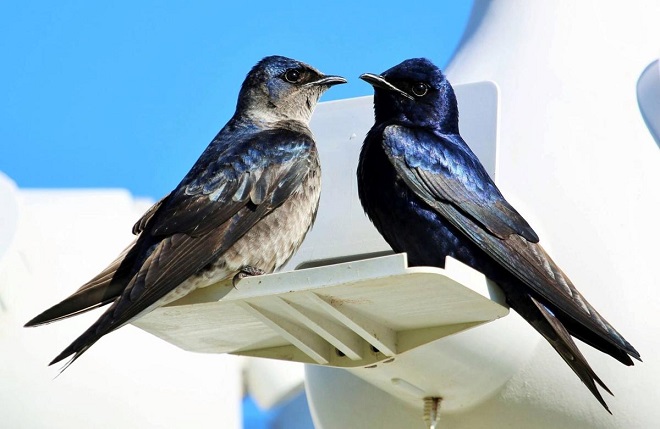Early Bird: America’s beloved Purple Martins return to Massachusetts

Spotting of birds in Mashpee, MA marks the state’s first sign of spring
Erie, PA (April 13, 2021)—In a sure sign that spring is not far behind, the first Purple Martins of the year have been spotted in Massachusetts.
The birds were seen on April 3 in the town of Mashpee by a Purple Martin enthusiast – one of many people throughout the eastern and central United States who track and report on the birds’ annual migration on behalf of the Purple Martin Conservation Association.
“The Purple Martins arrival in Massachusetts show the birds are making steady progress northward since they first made landfall in Florida two days before Christmas,” said Joe Siegrist, President of the Purple Martin Conservation Association. “Tracking the migration is not only fun, it also provides us with valuable information that helps inform our research and strengthen our efforts to make sure we’re doing everything possible to sustain the population of these amazing birds.”
North America’s largest species of swallow, Purple Martins winter in the rainforests of Brazil before making up to a 7000-mile migration north into the eastern United States and Canada.
The annual migration is a testament to the martins’ resilience as well as the unwavering dedication of thousands of ‘martin landlords’ who maintain multi-compartment nest ‘condos’ that are essential for the birds’ survival. Once widespread in rural America, this species, that eats billions of flying insects annually, has been disappearing at an alarming rate, experiencing a loss of one-third of its population over the last 50 years.
“The decline seems to be the combination of a few factors: nesting habitat loss, competing invasive species, decreasing prey availability, and climate change,” said Siegrist. “Over the majority of the Purple Martins’ range, they are unable to nest naturally any longer. Human-provided nest boxes are the only thing keeping the species alive east of the Rocky Mountains.”
Siegrist says the very survival of the species is due in large part to scores of dedicated conservationists who invest their time, money and hearts into maintaining housing for the martins.
“The landlords provide critical shelter for the martins,” Siegrist said. “In return, they are rewarded with a family-like bond with the birds who return to the same colony year after year like clockwork.”
To follow along with the Purple Martins’ migration and learn more about how you can help conserve this treasured bird, visit www.purplemartin.org. In addition, people interested in learning more about how to attract and care for Purple Martins can receive a free booklet by contacting the Purple Martin Conservation Association by emailing info@purplemartin.org or calling 814-833-7656.
Based in Erie, Pa. the Purple Martin Conservation Association is an international tax exempt, nonprofit organization dedicated to the conservation of the Purple Martin through scientific research, state of the art wildlife management techniques and public education.
The PMCA serves as a centralized data-gathering and information source on the species, serving both the scientist and Purple Martin enthusiast. The PMCA’s mission is educating martin enthusiasts in the proper techniques for managing this human-dependent species.
